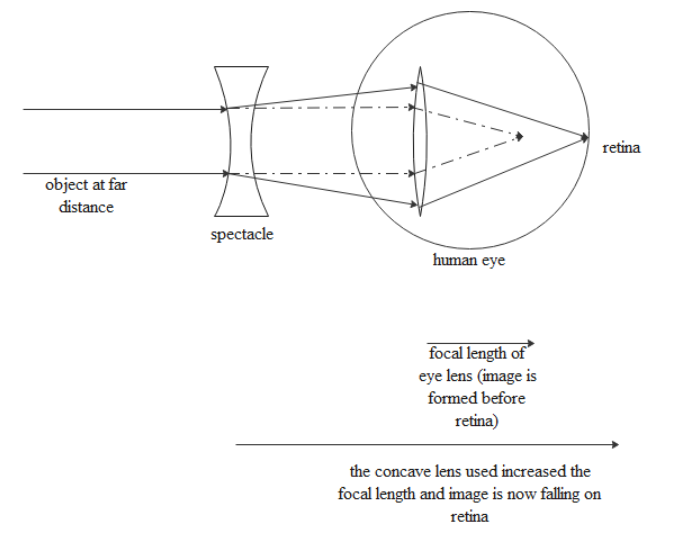
The power of the spectacle used for myopic eye is given as,
A. negative
B. positive
C. both positive and negative
D. none of the above
Answer
575.7k+ views
Hint: The spectacle is usually defined as the eye glasses. It is used when there is any defect for the human eye in order to rectify it. Myopia is also known as short sightedness. These all may help you to solve this question.
Complete step-by-step answer:
Myopia or otherwise called nearsightedness is a common trouble in vision in which we can see the things which are close to us clearly. But the things kept at a distance will not be viewed clearly. It happens if the shape of your eye will result in light rays to refract imperfectly, focusing images in front of our retina rather on your retina. This short-sightedness forms if the eyeball is very long so it affects the cornea and lens. This actually means that the objects in a distance are visible blurry due to the focusing of light rays in the front of the retina instead of being directly on its surface. The myopic eye or the defective eye can focus rays from a farther object in front of the retina. Hence they will be diverging when they incident on the retina which produces a blurry image.
Using the lens equation,
$\dfrac{1}{v}-\dfrac{1}{u}=\dfrac{1}{f}$
As the object is far away,
$u=\infty $
Let us assume the image distance is $v$. So by knowing a person’s far point, the focal length of the spectacle used can be calculated.
$\dfrac{1}{v}=\dfrac{1}{f}$
As generally the concave lens is used the focal length will be negative, hence the power also.
$P=\dfrac{1}{f}=\text{negative}$
That means the image produced by an eye lens should be at this distance or nearer for the myopic person to be able to see it perfectly. Therefore the focal length of the lens should be negative. Hence the answer is option A.

Note: Nearsightedness can be corrected by the usage of eyeglasses, contact lenses or by means of refractive surgery. According to the degree of our myopia, we should have to wear spectacle or contact lenses all the time or only if we require a very perfect distant vision. This will be useful in situations like when driving, seeing a chalkboard or watching a movie.
Complete step-by-step answer:
Myopia or otherwise called nearsightedness is a common trouble in vision in which we can see the things which are close to us clearly. But the things kept at a distance will not be viewed clearly. It happens if the shape of your eye will result in light rays to refract imperfectly, focusing images in front of our retina rather on your retina. This short-sightedness forms if the eyeball is very long so it affects the cornea and lens. This actually means that the objects in a distance are visible blurry due to the focusing of light rays in the front of the retina instead of being directly on its surface. The myopic eye or the defective eye can focus rays from a farther object in front of the retina. Hence they will be diverging when they incident on the retina which produces a blurry image.
Using the lens equation,
$\dfrac{1}{v}-\dfrac{1}{u}=\dfrac{1}{f}$
As the object is far away,
$u=\infty $
Let us assume the image distance is $v$. So by knowing a person’s far point, the focal length of the spectacle used can be calculated.
$\dfrac{1}{v}=\dfrac{1}{f}$
As generally the concave lens is used the focal length will be negative, hence the power also.
$P=\dfrac{1}{f}=\text{negative}$
That means the image produced by an eye lens should be at this distance or nearer for the myopic person to be able to see it perfectly. Therefore the focal length of the lens should be negative. Hence the answer is option A.

Note: Nearsightedness can be corrected by the usage of eyeglasses, contact lenses or by means of refractive surgery. According to the degree of our myopia, we should have to wear spectacle or contact lenses all the time or only if we require a very perfect distant vision. This will be useful in situations like when driving, seeing a chalkboard or watching a movie.
Recently Updated Pages
A man running at a speed 5 ms is viewed in the side class 12 physics CBSE

State and explain Hardy Weinbergs Principle class 12 biology CBSE

Which of the following statements is wrong a Amnion class 12 biology CBSE

Two Planoconcave lenses 1 and 2 of glass of refractive class 12 physics CBSE

The compound 2 methyl 2 butene on reaction with NaIO4 class 12 chemistry CBSE

Bacterial cell wall is made up of A Cellulose B Hemicellulose class 12 biology CBSE

Trending doubts
What are the major means of transport Explain each class 12 social science CBSE

Which are the Top 10 Largest Countries of the World?

Draw a labelled sketch of the human eye class 12 physics CBSE

Explain sex determination in humans with line diag class 12 biology CBSE

The pH of the pancreatic juice is A 64 B 86 C 120 D class 12 biology CBSE

Give 10 examples of unisexual and bisexual flowers




